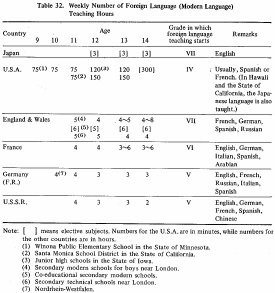| Home > Policy > White Paper, Notice, Announcement > White Paper > EDUCATIONAL STANDARDS IN JAPAN 1971 > CHAPTER |
||
In recent years, with scientific and technological developments, and the increase in international cooperation and international understanding, importance has been attached to foreign language teaching at the elementary and secondary education levels.
In Japan, foreign language teaching starts in lower secondary schools, for the purpose of "developing the basic abilities of pupils to understand and speak foreign languages, deepening pupils' consciousness of language, and establishing the foundation for international understanding". Although foreign languages are not required subjects, a great majority of pupils study English.

Note: [ ] means elective subjects. Numbers for the U.S.A. are in minutes, while numbers for the other countries are in hours.
(l) Winona Public Elementary School in the State of Minnesota.
(2) Santa Monica School District in the State of California.
(3) Junior high schools in the State of Iowa.
(4) Secondary modern schools for boys near London.
(5) Co-educational secondary modern schools.
(6) Secondary technical schools near London.
(7) Nordrhein-Westfalen.
Foreign language teaching starts at an earlier stage in other countries than in Japan. In the Federal Republic of Germany, it starts at the age of ten. In England and Wales, France and the U.S.S.R., it is a required subject starting at the age of eleven. In the U.S.A., elementary schools which teach foreign languages are rapidly increasing in number. In the countries considered, foreign language teaching is provided by the age of eleven at the latest. On the other hand, it starts at the age of twelve in Japan.
Foreign language teaching is provided as an elective subject in some junior high schools in the U.S.A. and in secondary modern schools in England and Wales. Generally, pupils are required to take one or two foreign languages, and it is even possible to take more than two foreign languages in the countries considered.
In vocational programs at the upper stage of secondary education, foreign languages are usually elective.
The method of teaching foreign languages has been changing in recent years from grammar-centered to practical usage emphasizing hearing and speaking before reading. Teaching foreign languages without use of the mother tongue has also been employed to a considerable extent.
Foreign languages are usually taught to smaller groups than is the case in other general subjects. For example, in France and the U.S.S.R., the size of class foreign languages is below 23.In the U.S.A. and the. U.S.S.R., special education is provided for the gifted.
In the U.S.S.R., special schools exist to teach English and French to children during and after the second grade.
| Back to Top | MEXT HOME |